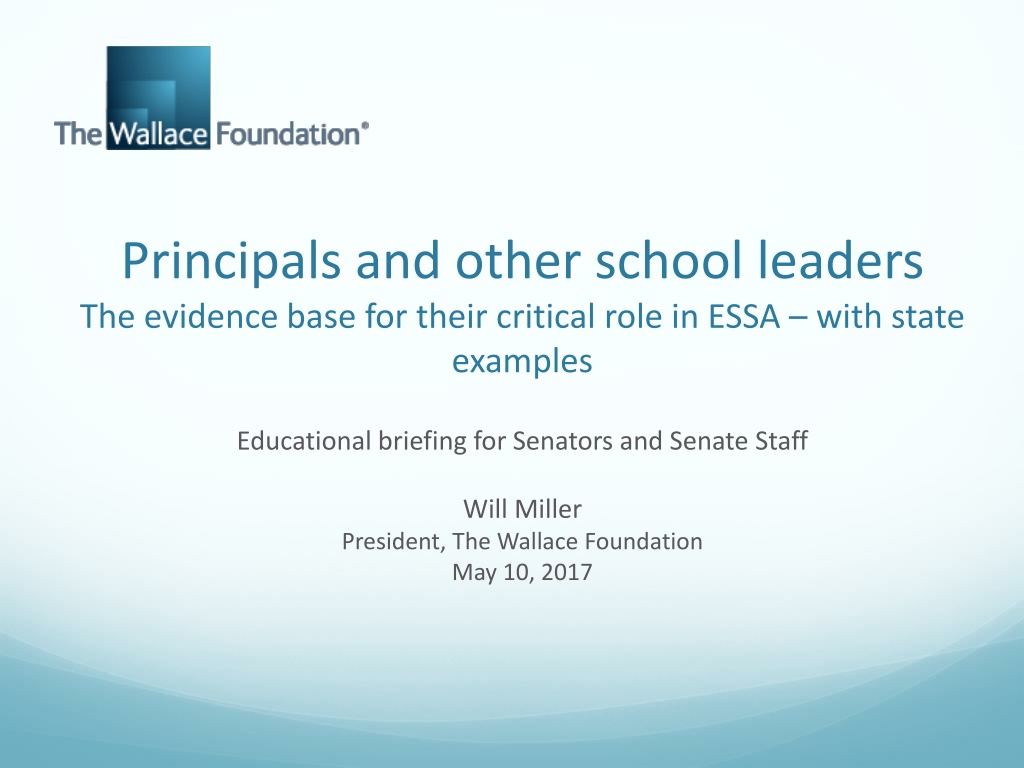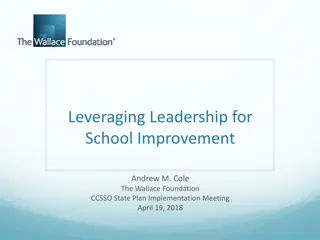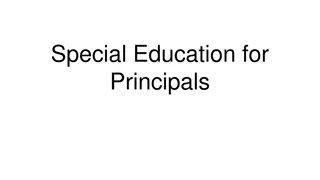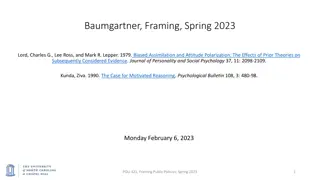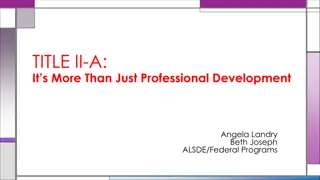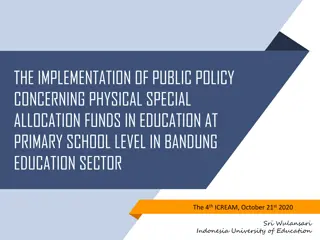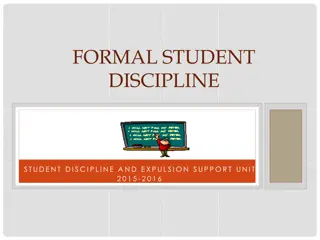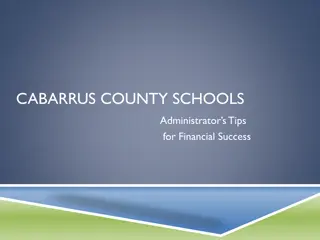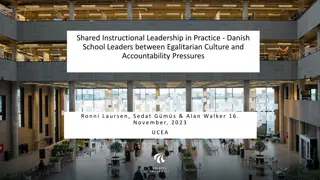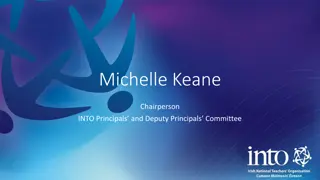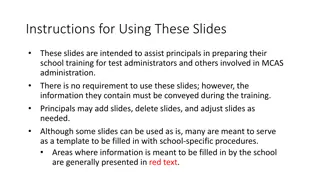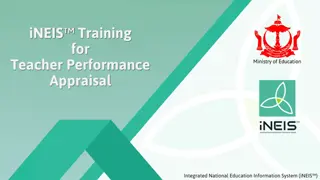The Critical Role of Principals in Education: Evidence and State Examples
The briefing by Will Miller discusses the crucial role of principals and school leaders in the context of ESSA, emphasizing the evidence base supporting their impact on student learning and teacher retention. Wallace Foundation's commitment to sharing reliable information and evidence is highlighted, along with state examples of how education leadership is emphasized in ESSA plans. Principals are showcased as key to student learning and teacher retention based on research findings.
Download Presentation

Please find below an Image/Link to download the presentation.
The content on the website is provided AS IS for your information and personal use only. It may not be sold, licensed, or shared on other websites without obtaining consent from the author. Download presentation by click this link. If you encounter any issues during the download, it is possible that the publisher has removed the file from their server.
E N D
Presentation Transcript
Principals and other school leaders The evidence base for their critical role in ESSA with state examples Educational briefing for Senators and Senate Staff Will Miller President, The Wallace Foundation May 10, 2017
Outline The Wallace Foundation The evidence base for education leadership How states are emphasizing education leadership in their ESSA plans 2
About Wallace Our mission is to foster improvements in learning and enrichment for disadvantaged children and the vitality of the arts for everyone Since 2000 Wallace has supported improvements and evidence on effective school principals as a lever for school improvement Wallace seeks to share evidence that can improve practice and policy Wallace s founders 3
Our commitment to evidence: We say more only as we know more We act at all times in ways that reflect our commitment to sharing only reliable, credible information and evidence with policymakers, practitioners and others. We seek to avoid causing harm or creating negative unintended consequences, by promoting specific policies and practices only when we have experience and evidence of their effectiveness. We seek to ensure that we are always viewed as a nonpartisan honest broker of useful lessons and evidence. We seek to comply fully at all times with the laws governing private foundation activities in the public policy realm. We actively seek out counter indicators of policy harm or counter indicators of the soundness of our policy strategies, and acknowledge contrary evidence in our policy analysis. Recognizing that evidence rarely suggests a single policy solution and that policy is most effective when adapted to local circumstances, we will always offer a set of evidence-based policy options, not a single prescription. 4
Outline The Wallace Foundation The evidence base for education leadership How states are emphasizing education leadership in their ESSA plans 5
Principals are key to student learning Principals are second only to classroom instruction among all school-related factors that contribute to what students learn at school. -- How Leadership Influences Student Learning, Kenneth Leithwood, et al, University of Minnesota, University of Toronto, 2004 6
Principals are key to retaining good teachers Teacher turnover is lower in schools led by high-quality principals . Research further indicates that principal turnover leads to lower teacher retention and lower gains for students. -- School Leadership Interventions Under the Every Student Succeeds Act: Evidence Review, Rebecca Herman, et al, RAND, 2016 Principal effectiveness is associated with greater teacher satisfaction and a lower probability that the teacher leaves the school within a year. Moreover, the positive impacts of principal effectiveness on these teacher outcomes are even greater in disadvantaged schools. -- Can Good Principals Keep Teachers in Disadvantaged Schools? Linking Principal Effectiveness to Teacher Satisfaction and Turnover in Hard-to-Staff Environments, Jason A. Grissom, Teachers College Record, 2011 7
Principals are critical to improving struggling schools there are virtually no documented instances of troubled schools being turned around without intervention by a powerful leader. Many other factors may contribute to such turnarounds, but leadership is the catalyst. -- How Leadership Influences Student Learning, Kenneth Leithwood, et al, University of Minnesota, University of Toronto, 2004 8
Leadership is a crucial ingredient in most school reform initiatives The chance of any reform improving student learning is remote unless district and school leaders agree with its purposes and appreciate what is required to make it work There seems little doubt that both district and school leadership provides a critical bridge between most educational-reform initiatives, and having those reforms make a genuine difference for all students. -- How Leadership Influences Student Learning, Kenneth Leithwood, et al, 2004 9
Principals strengthen the impact of effective teaching and are cost-effective Principals are multipliers of effective teaching. --Developing Excellent School Principals to Advance Teaching and Learning: Considerations for State Policy-- Paul Manna, The Wallace Foundation, 2015 Efforts to improve [principals ] recruitment, training, evaluation and ongoing development should be considered highly cost-effective approaches to successful school improvement. -- How Leadership Influences Student Learning, 2004 10
30+ studies on school leadership meet ESSA evidence requirements 18 meet Tiers I through III evidence requirements Key conclusions: School leadership can be a powerful driver of improved education outcomes. Activities designed to improve school leadership demonstrate positive impact on student, teacher, and principal outcomes . 11
Outline The Wallace Foundation The evidence base for education leadership How states are emphasizing education leadership in their ESSA plans 12
34 states and D.C. working with Wallace and/or CCSSO on school leadership strategies Hawaii Wallace/CCSSO CCSSO 13
Selected national partners working with Wallace on school leadership Council of Chief State School Officers American Association of Colleges of Teacher Education National Governors Association University Council for Educational Administration National Council of State Legislatures George W. Bush Institute Council of the Great City Schools National Urban League RAND American Association of School Administrators Policy Studies Associates National Association of Elementary School Principals National Association of Secondary School Principals 14
ESSA clarified that states can use federal funds to support principals and states are responding According to CCSSO, at least 25 states feature school leadership strategies in draft ESSA plans 13 states using 3% set-aside in Title II, Part A to strengthen principals 12 states have plans focused on school leaders but are unclear on the set aside ESSA state plans include support for principals using Titles I and II Principal training academies Mentoring Principal supervisors Principal pipelines Retaining principals in high needs schools 15
How Tennessee and Missouri plan to use Title II, Part A for principals Both states using 3% set-aside to implement strategies based on evidence Tennessee Under Commissioner Candice McQueen, Tennessee will fund the implementation of the Tennessee Transformational Leadership Alliance s plan to develop regional partnerships between districts and universities to create pipelines of high-quality principals Strong focus on leadership in school improvement strategies Missouri Under Commissioner Margaret Vandeven, Missouri will move toward training and coaching for all principals in the state at scale. Next year will offer intensive training and support for principals in their first or second years with other sessions for principals of three years and up. The state will coordinate all training with a larger system of workforce development and will pay for all principal mentoring; whereas previously districts assumed the cost. Note: This slide was revised to incorporate additional information. 16
Executive summary Wallace s commitment to evidence: We say more only as we know more Effective principals: Are critical to turning around challenging schools Are crucial to the success of most school improvement efforts Help retain and support the best teachers Improving school leadership is a cost-effective strategy 30+ studies on school leaders meet ESSA evidence requirements At least 25 states feature school leadership in their draft ESSA plans They include: Statewide leadership academies, mentoring, principal supervisors, and principal pipelines 17
www.wallacefoundation.org The foundation maintains an online library of objective evidence on school leadership and other topics available without charge 18
The Wallace Foundation is a private foundation and does not engage in lobbying activities as defined by the Internal Revenue Code. These materials constitute non-partisan analysis and research intended for educational purposes only. 19
